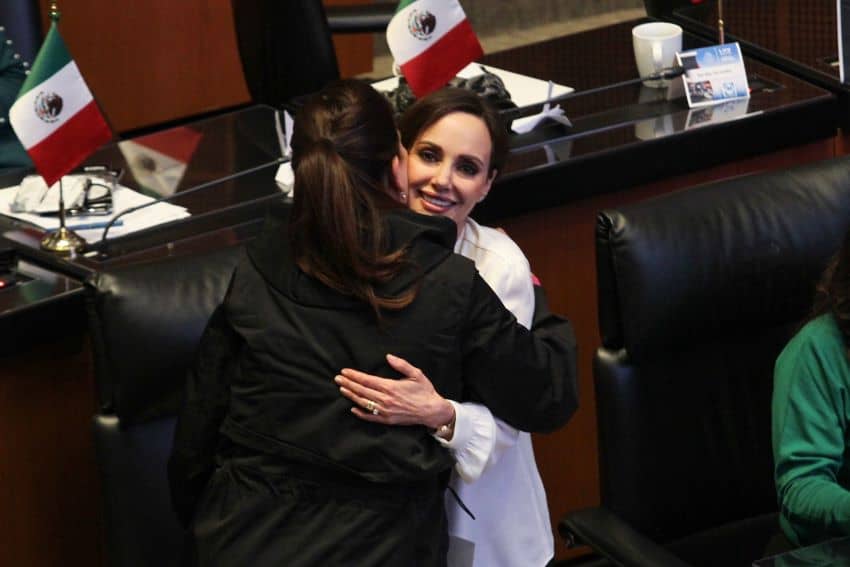Why so close? The concept of personal space is different in Mexico

It’s been 21 years, but a part of me still feels a little flustered giving and getting pecks on the cheek.
It’s not that I agonize over it. It’s just that this perfectly normal way in Mexico of meeting and greeting non-family members and then bidding them adieu will never feel to me, on a cellular level, 100% non-sexual.
To this gal from a country where Puritans were the cultural founders of the current regime, it feels ever-so-slightly mischievous.
If you’ve spent any amount of time in Mexico, you’ve probably noticed it: this population’s sense of personal space is a bit different than ours, “ours” meaning those of us from the countries that currently send the most visitors and immigrants Mexico’s way.
So in the spirit of cultural knowledge-sharing, let’s dive right into the spaces between what’s considered familiar and normal in Mexico.
First, a general statement: Mexico is a much more “touchy-feely” country than its north-er North American counterparts, the United States and Canada. While there will always be variety among individuals within a culture, we know for our own on an instinctual level what’s normal and what’s not. For unfamiliar cultures, there’s some learning to be done!
Normal: Standing, walking, and talking very close to you. The short explanation: this is a matter of the physical space available and how many people live and reside within a certain area.
You’ve probably noticed that this is not a country of wide, open spaces… or at least people don’t tend to live in its wide, open spaces, anyway. Lots of things seem smaller, too, because they are: the aisles in the grocery store, the parking spaces, the cars, the bathrooms, the tables and chairs, the streets, the sidewalks, the buses, the metro (oh God, the metro).
When this is the case, you just get used to being a little cozier all around, as eventually people simply stop noticing when they’re closer than they need to be (to the point, sometimes, that you can easily smell people’s breath when they talk). Ick, and you’re allowed to back up or turn to the side if they don’t catch the hint and mindlessly follow you; “This is my good ear,” I might say to be polite. The smaller spaces also mean that most people are oblivious to the fact that you think they have any polite responsibility at all to move over to let you rush past them on the sidewalk. Move where?
Not normal: Standing or sitting right next to you when it’s not necessary to do so. If you’re packed into a metro, chances are you’re going to be standing pretty darn close to others. If you’re on a nearly-empty bus and someone plops down in the seat right next to you, though, you might want to get up and move toward the driver.

Especially if you’re a woman, you’ll want to be cautious with distance. If your spidey senses are telling you that some dude is standing way closer behind you in line than he needs to, a full-bodied turn to the side (pro tip: get your butt to a point where it’s not facing him) and a quick “What do you want?” look is totally called for.
Normal: Quick pecks on the cheek to meet, greet, and bid farewell to friends and acquaintances, mostly in casual social situations. Ah, the kiss. If you’re from a place where kisses are mostly reserved for romantic partners and one’s own young children, kissing people who don’t fall into those categories might always feel just a little bit devious to you. It still does to me, and I’ve been here for over two decades. But oh, how I love having a set physical protocol and the bookends that they naturally put on either end of social interactions!
So how’s it done, exactly? First, it’s most typical to go in for it by moving your head slightly to the left. You’ll likely touch cheeks with the other person, but the kiss will mostly be in the air next to them and will not necessarily land on their skin. If you’re just meeting the other person, this might be accompanied by a simultaneous handshake that begins a second or so before, and if you already know them, you might lightly grab their left shoulder as well before pulling apart. If you’re good friends, a full-on hug could happen, too – oh, boy! Women and women kiss, women and men kiss, and men and men usually shake hands and maybe do the shoulder squeeze thing or a hug.
If you really don’t want to kiss-greet someone, just offer your hand for a shake, and use it to keep the distance between your bodies, which should get the message across.
Not Normal: Kisses from random strangers or in professional settings, and slobbery kisses planted firmly on your cheek (or on your mouth – yikes!). Remember, kisses are not required or expected in all social situations: you don’t kiss the clerk at the grocery store or the immigration officer or the person who’s interviewing you for a job.

When I taught high school, I did not greet or say goodbye to my students with kisses – not even the ones I was on a friendly basis with (plus, we’d have never had time for the actual class!). Mexicans tend to be unshy about respecting social hierarchies, and it would be rare to lean in for a kiss toward someone in a position of either authority or subordination in relation to you, or you to them.
When in doubt, a handshake is always polite!
Normal: Hugs from good friends and family members; a light touch on the shoulder or arm from a stranger who needs your attention. It’s interesting to note that in a culture generally more comfortable with physical closeness and touching, hugs seem to be considered more intimate here than those air kisses next to the cheek. But if you think about it, it makes quite a bit of sense: a short moment of facial closeness is a lot less contact than pressing your entire bodies against each other for a few seconds! That’s why hugs are usually reserved for really good friends, family, and romantic partners.
Not normal: Hugs from strangers, or even acquaintances that you’re not close to; a stranger grabbing you or touching you anywhere below your shoulder. If you don’t want to press your body up against someone else’s, by all means, don’t – you’re not obliged! And if a stranger grabs you around your waist, whip around and give a well-deserved “back off” dirty look.
So there you have it! This is an article and not a book, of course, and is therefore not an exhaustive list. But I hope it’s given you at least a somewhat broad idea of what to expect in your personal interactions in Mexico. Go forward and kiss the air next to people’s faces!
Or maybe just a handshake.
Sarah DeVries is a writer and translator based in Xalapa, Veracruz. She can be reached through her website, sarahedevries.substack.com.
Source: Mexico News Daily

